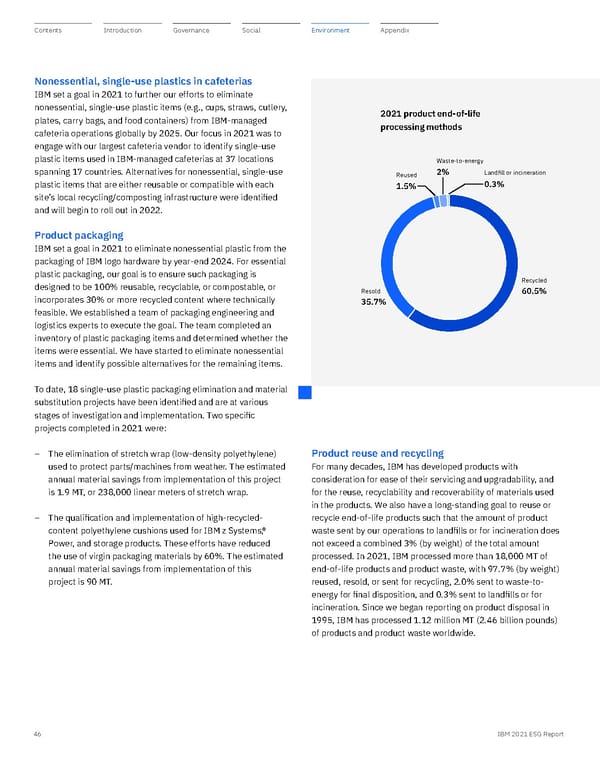Nonessential, single-use plastics in cafeterias IBM set a goal in 2021 to further our efforts to eliminate nonessential, single-use plastic items (e.g., cups, straws, cutlery, plates, carry bags, and food containers) from IBM-managed cafeteria operations globally by 2025. Our focus in 2021 was to engage with our largest cafeteria vendor to identify single-use plastic items used in IBM-managed cafeterias at 37 locations spanning 17 countries. Alternatives for nonessential, single-use plastic items that are either reusable or compatible with each site’s local recycling/composting infrastructure were identified and will begin to roll out in 2022. Product packaging IBM set a goal in 2021 to eliminate nonessential plastic from the packaging of IBM logo hardware by year-end 2024. For essential plastic packaging, our goal is to ensure such packaging is designed to be 100% reusable, recyclable, or compostable, or incorporates 30% or more recycled content where technically feasible. We established a team of packaging engineering and logistics experts to execute the goal. The team completed an inventory of plastic packaging items and determined whether the items were essential. We have started to eliminate nonessential items and identify possible alternatives for the remaining items. To date, 18 single-use plastic packaging elimination and material substitution projects have been identified and are at various stages of investigation and implementation. Two specific projects completed in 2021 were: – The elimination of stretch wrap (low-density polyethylene) used to protect parts/machines from weather. The estimated annual material savings from implementation of this project is 1.9 MT, or 238,000 linear meters of stretch wrap. – The qualification and implementation of high-recycled- content polyethylene cushions used for IBM z Systems,® Power, and storage products. These efforts have reduced the use of virgin packaging materials by 60%. The estimated annual material savings from implementation of this project is 90 MT. 2021 product end-of-life processing methods Product reuse and recycling For many decades, IBM has developed products with consideration for ease of their servicing and upgradability, and for the reuse, recyclability and recoverability of materials used in the products. We also have a long-standing goal to reuse or recycle end-of-life products such that the amount of product waste sent by our operations to landfills or for incineration does not exceed a combined 3% (by weight) of the total amount processed. In 2021, IBM processed more than 18,000 MT of end-of-life products and product waste, with 97.7% (by weight) reused, resold, or sent for recycling, 2.0% sent to waste-to- energy for final disposition, and 0.3% sent to landfills or for incineration. Since we began reporting on product disposal in 1995, IBM has processed 1.12 million MT (2.46 billion pounds) of products and product waste worldwide. Landfill or incineration 0.3% Resold 35.7% Recycled 60.5% Waste-to-energy 2% Reused 1.5% 46 IBM 2021 ESG Report
 ESG Report | IBM Page 45 Page 47
ESG Report | IBM Page 45 Page 47